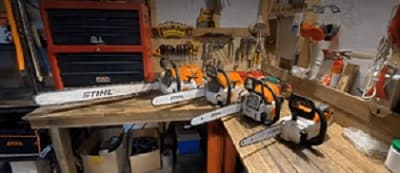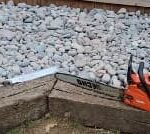As an Amazon Associate, this site earns commissions from qualifying purchases. For more information click here.
Chainsaws are ideal for cutting trees, but what is the right size to use? How do you measure a chainsaw so that is it right for the task you have in mind? You do not want one that is too small, but if the saw is too big that would be impractical too. To help you, this article will reveal the right chainsaw sizes for cutting trees and other related tasks.
A 16-18 inch chainsaw can cut small to medium sized trees, branches and firewood. For large, thick trees, you need at the very least a 20 inch chainsaw with a powerful engine.
Chainsaw Cutting Power Comparison
The chainsaw bar is used to determine its cutting capacity. Also known as the blade, it is the thin, rectangular metal where the chain rests. To find the right chainsaw for your task, you have to know the bar size.
- Buying the biggest, longest chainsaw is not always ideal. They are powerful but also heavy. If you have to cut lots of trees the weight will become a factor.
- A mall chainsaw will not do either. If the bar is too small the tool will not have enough power to cut through the wood. So choosing the right blade size is a must.
We will explain how to measure the bar shortly. But if you just want to know the chainsaw sizes for cutting trees, check this guide.
| Chainsaw Size | Best For |
|---|---|
| 6-10 in. | Saplings, small limbs |
| 8-12 in. | Branches and twigs |
| 12-16 in. | Small to medium logs, small trees |
| 16-18 in | Small to medium sized trees |
| 20 in. and above | Large trees |
When choosing a chainsaw, the blade has to be two inches longer than the maximum diameter of what you will cut. An 18 inch chainsaw such as the Poulan Pro PR4218 can cut trees up to 14 inches in diameter maximum. If you have a 22 inch blade, it can cut trees up to 20 inches thick and so on.
A 16 inch chainsaw might be able to cut a 16 inch thick tree. But that requires multiple cuts instead of one. More cuts take more time and consumes more engine power. For smoother, more efficient performance you should keep the 2 inch rule in mind.
Chainsaw Engine Size
Aside from the bar size, the engine must be powerful enough to power the blade. Your owner’s manual has information on the engine to bar size ratio.
For chainsaw bars 12 inches and below, a 25cc engine or less is recommended. If you are using 12-16 inch bars, get a 26-35cc. For 20 inch and larger bars, a 36cc is the minimum required.
Basically the larger the engine, the larger the bar you can use. If the engine is too small, it is time to buy a larger chainsaw. Unlike a bar, you cannot just put a bigger one into the saw.
What Chainsaw Size Should You Use?
It depends on what type of trees you have to cut. There are a lot of chainsaws and deciding what to use can be overwhelming for a beginner. To make it easier to understand, these tips are divided between cutting small and large trees.

Small to Medium Sized Trees
For cutting small and medium trees, a 10-14 inch chainsaw is enough. A corded or battery powered model is going to be up to the task. Branches, saplings and vines are not going to be problems here.
A good quality battery powered chainsaw will do fine here. You can also use electric models though you are limited by the cord length. Unlike a battery however, corded saws do not run out of power.
If you only cut small to medium sized trees a few times a year, a 14 inch chainsaw is just about right. These are suitable for maintaining small yards and performing regular maintenance. 14 inch chainsaws are available both as corded and cordless models.
Battery and electric chainsaws are lighter to carry compared to gas. And for pruning, trimming and cutting they get the job done. These chainsaws also need less maintenance than a gas powered one.
For Large Trees
For large trees you need a 20 inch gas powered chainsaw minimum. A 16-18 chainsaw will also work though it will require multiple passes for thick trees.
If you have to fell several large trees, do not settle for anything less than a 20 inch chainsaw. If we are talking hardwood trees then you might need an even larger bar. When it comes to large trunks, it helps to have a powerful engine too. We suggest going with the Husqvarna 455 Rancher 20 inch chainsaw because it has the durability and power needed for these tasks.
The rule with cutting large trees is if the engine can handle a longer chainsaw bar, go for it. A 45cc engine for instance, can power a 24 inch bar. If your property has a lot of trees that need to be felled down –or you are in the woodcutting business – investing in a large chainsaw is ideal.
If you have never used a chainsaw before, start with a light one, preferably corded or battery. You might be surprised at how heavy it can be.
How to Measure a Chainsaw Bar For Tree Cutting
The bar size can be found on the bar. If the print has faded, you can also find it in your owner’s manual or the manufacturer website.
If you are going to replace the bar and want to be sure, get a measuring tape. Measure from the point where the bar goes into the engine up to the end of the bar chain. The result should be an even number. If not, round it off to the nearest even number and you have the chainsaw bar length.
Can I Replace My Chainsaw Bar? If the bar is too short or too long, you can replace it. Keep in mind chainsaw bars are not universal so you have to choose one that is compatible.
Second, check the engine capacity. Even if your 10 inch chainsaw can fit a 16 inch bar, the engine might not be strong enough to power it. Your owner’s manual and the manufacturer website has information on the correct engine to chainsaw size.
Once you have replaced the bar and put on the chain, turn it on for a few minutes. Make sure the blade and the chain are secure before you start cutting any branches.
The chainsaw bar should only be as long as it needs to be. The longer the bar, the heavier it is. At full power the chainsaw will vibrate in your hands and can be difficult to hold steady. A very long chainsaw is prone to kickback so you should avoid it.
Guidelines for Cutting Trees with a Chainsaw
First, always protect yourself. Do not wear clothing that can get entangled with branches or limbs. Leg chaps, ear protection, steel toed boots, eye protection, gloves and a hard hat are necessary.
Decide first if you need to use a chainsaw. If you are cutting 1-3 inch branches, pruning shears might do the job. For 4 inch and thicker wood, a small chainsaw is ideal. If the branches 5-10 inches thick, the chainsaw should be at least 8 inches long, 12 is better.
A 14 inch chainsaw is a good size for cutting small to medium sized trees. As long as the branches are not too thick, these tools will work fine.
Bear in mind that a 14 inch chainsaw can cut a tree up to 12 inches in diameter in one pass. You can replace it with a 16 inch bar and the engine should have enough power for it. These chainsaws are also capable of cutting medium sized firewood logs up to 12 inches.
The key to efficient tree cutting is to do it in one go. Cutting through thick wood with multiple passes will wear you out. If you are using a heavy chainsaw you will feel the weight with each stroke. This is why it is best to get the right size for one pass cuttings.

I love the outdoors and all the tools for maintaining gardens, yards and lawns. The only thing I am more passionate about is sharing what I know about garden and outdoor equipment.


